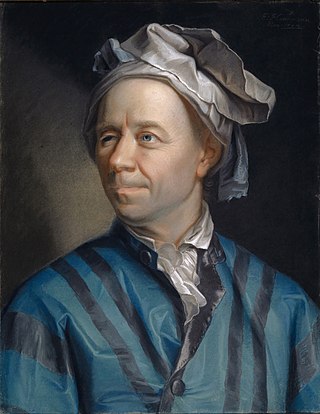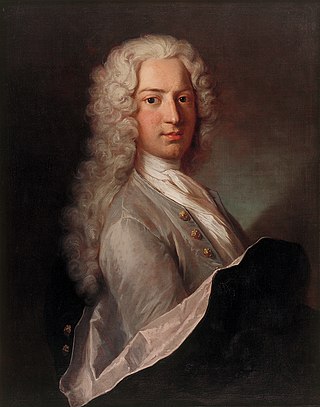
Differential geometry is a mathematical discipline that studies the geometry of smooth shapes and smooth spaces, otherwise known as smooth manifolds. It uses the techniques of differential calculus, integral calculus, linear algebra and multilinear algebra. The field has its origins in the study of spherical geometry as far back as antiquity. It also relates to astronomy, the geodesy of the Earth, and later the study of hyperbolic geometry by Lobachevsky. The simplest examples of smooth spaces are the plane and space curves and surfaces in the three-dimensional Euclidean space, and the study of these shapes formed the basis for development of modern differential geometry during the 18th and 19th centuries.

Leonhard Euler was a Swiss mathematician, physicist, astronomer, geographer, logician, and engineer who founded the studies of graph theory and topology and made pioneering and influential discoveries in many other branches of mathematics such as analytic number theory, complex analysis, and infinitesimal calculus. He introduced much of modern mathematical terminology and notation, including the notion of a mathematical function. He is also known for his work in mechanics, fluid dynamics, optics, astronomy, and music theory.

Daniel Bernoulli was a Swiss mathematician and physicist and was one of the many prominent mathematicians in the Bernoulli family from Basel. He is particularly remembered for his applications of mathematics to mechanics, especially fluid mechanics, and for his pioneering work in probability and statistics. His name is commemorated in the Bernoulli's principle, a particular example of the conservation of energy, which describes the mathematics of the mechanism underlying the operation of two important technologies of the 20th century: the carburetor and the aeroplane wing.

Joseph-Louis Lagrange, also reported as Giuseppe Luigi Lagrange or Lagrangia, was an Italian mathematician, physicist and astronomer, later naturalized French. He made significant contributions to the fields of analysis, number theory, and both classical and celestial mechanics.
Louis François Antoine Arbogast was a French mathematician. He was born at Mutzig in Alsace and died at Strasbourg, where he was professor. He wrote on series and the derivatives known by his name: he was the first writer to separate the symbols of operation from those of quantity, introducing systematically the operator notation DF for the derivative of the function F. In 1800, he published a calculus treatise where the first known statement of what is currently known as Faà di Bruno's formula appears, 55 years before the first published paper of Francesco Faà di Bruno on that topic.

Method of Fluxions is a mathematical treatise by Sir Isaac Newton which served as the earliest written formulation of modern calculus. The book was completed in 1671 and posthumously published in 1736.
The year 1755 in science and technology involved some significant events.

Anders Johan Lexell was a Finnish-Swedish astronomer, mathematician, and physicist who spent most of his life in Imperial Russia, where he was known as Andrei Ivanovich Leksel.

In mathematics, a differential equation is an equation that relates one or more unknown functions and their derivatives. In applications, the functions generally represent physical quantities, the derivatives represent their rates of change, and the differential equation defines a relationship between the two. Such relations are common; therefore, differential equations play a prominent role in many disciplines including engineering, physics, economics, and biology.
The 18th-century Swiss mathematician Leonhard Euler (1707–1783) is among the most prolific and successful mathematicians in the history of the field. His seminal work had a profound impact in numerous areas of mathematics and he is widely credited for introducing and popularizing modern notation and terminology.

Elements of Algebra is an elementary mathematics textbook written by mathematician Leonhard Euler around 1765 in German. It was first published in Russian as "Universal Arithmetic", two volumes appearing in 1768-9 and in 1770 was printed from the original text. Elements of Algebra is one of the earliest books to set out algebra in the modern form we would recognize today, and is one of Euler's few writings, along with Letters to a German Princess, that are accessible to the general public. Written in numbered paragraphs as was common practice till the 19th century, Elements begins with the definition of mathematics and builds on the fundamental operations of arithmetic and number systems, and gradually moves towards more abstract topics.
In mathematics, 1 − 2 + 4 − 8 + ⋯ is the infinite series whose terms are the successive powers of two with alternating signs. As a geometric series, it is characterized by its first term, 1, and its common ratio, −2.

Institutiones calculi integralis is a three-volume textbook written by Leonhard Euler and published in 1768. It was on the subject of integral calculus and contained many of Euler's discoveries about differential equations.
William Wade Dunham is an American writer who was originally trained in topology but became interested in the history of mathematics and specializes in Leonhard Euler. He has received several awards for writing and teaching on this subject.

A timeline of calculus and mathematical analysis.

Introductio in analysin infinitorum is a two-volume work by Leonhard Euler which lays the foundations of mathematical analysis. Written in Latin and published in 1748, the Introductio contains 18 chapters in the first part and 22 chapters in the second. It has Eneström numbers E101 and E102.
Mechanica is a two-volume work published by mathematician Leonhard Euler which describes analytically the mathematics governing movement.
In mathematics, the arctangent series, traditionally called Gregory's series, is the Taylor series expansion at the origin of the arctangent function:











